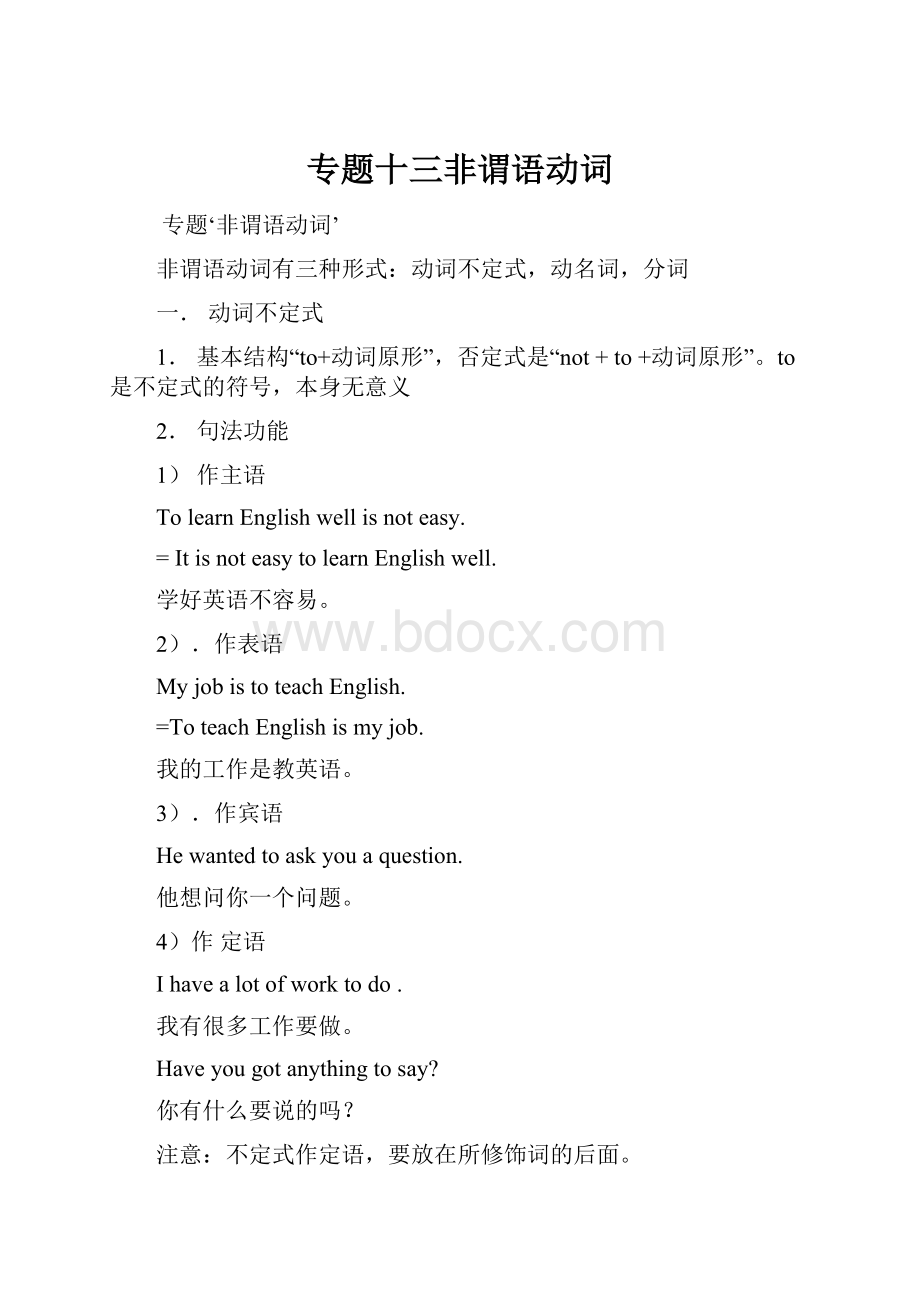专题十三非谓语动词.docx
《专题十三非谓语动词.docx》由会员分享,可在线阅读,更多相关《专题十三非谓语动词.docx(16页珍藏版)》请在冰豆网上搜索。

专题十三非谓语动词
专题‘非谓语动词’
非谓语动词有三种形式:
动词不定式,动名词,分词
一.动词不定式
1.基本结构“to+动词原形”,否定式是“not+to+动词原形”。
to是不定式的符号,本身无意义
2.句法功能
1)作主语
TolearnEnglishwellisnoteasy.
=ItisnoteasytolearnEnglishwell.
学好英语不容易。
2).作表语
MyjobistoteachEnglish.
=ToteachEnglishismyjob.
我的工作是教英语。
3).作宾语
Hewantedtoaskyouaquestion.
他想问你一个问题。
4)作定语
Ihavealotofworktodo.
我有很多工作要做。
Haveyougotanythingtosay?
你有什么要说的吗?
注意:
不定式作定语,要放在所修饰词的后面。
5)作目的状语
Hewenttothestationtomeethisfriend.
他去车站为了见他的朋友。
6)作宾语不足语
如:
asksb.todosth./tellsb.todosth./wantsb.todosth./wouldlikesb.todosth.
Myparentsdon’tallowmetowatchTVthisterm.
这学期父母不允许我看电视。
Motherasksmenottoplaycomputergamesbeforefinishingmyhomework.
妈妈告诉我在完成作业之前不能玩电脑游戏。
注意:
在make/let/see/hear/watch等使役,感官动词后,不定式省略to
makesb.dosth./seesb.dosth.
3.特殊疑问词+不定式
不定式可以和疑问代词who,what,which,疑问副词when,how,why,,where连用构成不定式短语
Theteacheristellingthestudentswhattodo.
教师在告诉学生们做什么。
Hedidn’tknowwheretogo.
他不知道去哪里。
二.动名词
由动词原形+ing构成
1.作主语
Swimminginthisriverisdangerous.
在这个河里游泳很危险。
2.作宾语
Helikesplayingfootballverymuch.
他非常喜欢踢足球。
Stampsareusedforsendingletters.
邮票是被用来寄信的。
3.作表语
Myhobbyiscollectingshells.
=Collectingshellsismyhobby.
我的爱好是收集贝壳。
4.作定语
Mymotherisinlivingroom.
我妈妈在客厅里。
注意:
这些动词常跟动名词作宾语:
finish/enjoy/mind/beworth/practice/havefun/spend/bebusy/giveup/beusedto/feellike等
Ienjoylisteningtomusic.
Thebookisworthreading.
三.分词
分词分为现在分词和过去分词。
现在分词表示主动和进行的意思。
过去分词表示完成和被动的意思。
1.作定语
Doyouknowthegirlstandingoverthere?
你知道站在那边的那个女孩吗?
Therearemanyfallenleavesontheground.
地上有许多落叶。
2.作状语
Beingill,hedidn’tgotoschool.
因为病了,他没有去上学。
3作表语
Iwaspleasedatthenews.
我听到这个消息很高兴。
4.作宾语不足语
Hekeptmewaitingforalongtime.
他让我等了很长时间。
四.易混易错点
1.hearsb.dosth./hearsb.doingsth.
Iheardhimsingingintheclassroom.(“唱歌”这个动作正在进行。
)
Iheardhimsingintheclassroom.(“唱歌”这个动作已经结束)
这样的动词如:
see,watch,notice,hear,find,have
2.thesurprisingnews令人惊讶的消息
asurprisedman一个惊讶的人
amovingfilm一场感人的电影
themovedpeople受感动的人们
3.thedevelopingcountry发展中国家
thedevelopedcountry发达国家
therisingsun正在升起的太阳
therisensun升起来的太阳
4.stoptodosth.停下来做某事
stopdoingsth。
停止作某事
remembertodosth.记住要做某事(动作未发生)
rememberdoingsth.记得曾做过某事(动作已发生)
goontodosth.做完一件事接着做另一件事
goondoingsth.继续不停做同一件事
如:
Stoptalking,please.请不要讲话。
Stoptothinkaboutitforamoment.停下来想一想。
Irememberpostingyourletter.
我记得把你的信寄出去了。
(信已寄出)
Pleaseremembertopostmyletter.
请记住把我的信寄走。
(信尚未寄出)
练习题:
1.Ialwaystellmystudents____ontheroadbecauseit’sreallydangerous.
A.nottoplayB.toplaynotC.notplayingD.notplay
2.----Nick,wouldyoumind____outofthebathroom?
----Sorry,Iwon’tbelong.
A.comeB.tocomeC.coming
3.Let’s______forawalk,shallwe?
A.togoB.goingC.goD.gone
4.---Don’tforget____yourhomework,John.
---OK.I’lldorightnow.
A.doingB.doC.todo
5.---Whydon’tyougoouttoplay,Rose?
---I’mafraidIcan’t.Ihavemuchhomework________.
A.doB.doesC.doingD.todo
6.Itwassuchafunnyshowthatpeoplecouldn’thelp_____againandagain.
A.laughB.tolaughC.laughing
7.Wheneveryouhaveachance___English,youshouldtakeit.
A.speakB.tospeakC.spokeD.speaks
8.It’stimeforsuppernow.Let’s___it.
A.stophavingB.stoptohaveC.tostoptohaveD.stoppingtohave
9.IsawLiMing_____neartheriveronmywayhome.
A.playsB.playingC.toplayD.played
10.----Whatabout_______arest?
---OK.Let’sgooutandhaveawalk.
A.totakeB.takesC.taking
11.Mygrandfatherhasacomputer,buthedoesn’tknow____touseit.
A.whatB.howC.whoD.which
12.---BobspeaksChinesequitewell.
---Yes,sohedoes.Hepractises___Chineseeveryday.
A.speakB.speakingC.speaksD.spoke
13.Hewas_______atthe____news.
A.surprised,surprisedB.surprised,surprisingC.surprising,surprising
专题十四主谓一致
一.主谓一致原则
1.当and/both…and连接两个或三个名词作主语时,谓语动词用复数形式。
Bothmyfatherandmymotheraredoctors.
JackandMikearegoodfriends.
2.不定代词either,neither,anybody,something,everyone,nobody,nothing等作主语时,谓语动词用单数形式
SomethingiswrongwithmyMP4.
我的MP4有毛病了。
Nothingisdifficultifyouputyourheartintoit.世上无难事,只怕有心人。
3.由each,every,each….and…,every…and…作主语时,谓语动词用单数形式
Eachboyandeachgirlhasbeengivenagift.
4.主语后有with,alongwith,togetherwith,aswellas,morethan,including,except等时,谓语动词的数由主语的形式决定。
Mr.GreenwithhiswifeandtwochildreniscomingtoBeijing.
格林先生将和他的夫人及两个孩子一块来北京。
AllexceptHarryhavepassedthedrivingtest.
除了Harry之外都通过了驾驶考试。
5.由apair(akind,apiece…)+of+复数名词,谓语动词用单数,pairs(kinds,pieces…)+of+复数名词,谓语动词用复数
Apairofnewshoesislyingonthefloor.
Twentypairsofpantsaremadeeachday.
5.不定式或v.—ing形式作主语时,谓语用单数
Seeingisbelieving.眼见为实。
Readingislearning.读书就是学习。
二.意义一致原则
意义一致又叫概念一致,即谓语形式要看主语所表达的概念。
1.and连接的两个单数名词作主语,如果指同一概念,谓语用单数
Thesingeranddancerhasbeeninvitedtotheparty.
那位歌唱家兼舞蹈家已经被邀请参加晚会。
Theteacherandwriteriscomingtoourschooltomorrow.
那位老师兼作家明天要来我们学校。
2.表示度量,价格,时间,长度的复数名词作主语时,常被看作一个整体,谓语用单数
Threeyearsisalongtime.
100yuanisenoughforme.
3集体名词family,team,class,group,…表示集体中的成员,谓语用复数
AllmyfamilylikewatchingTV.
我们一家人都喜欢看电视。
三.就近原则
1.由either…or…,neither…nor…,notonly…butalso…或连接并列主语时,用就近原则
NeitherMarynoryouareright.
你和玛丽都不对。
NotonlyyoubutalsoMaryisright.
不但你对了,而且玛丽也对了。
2.在Therebe和Herebe两个句中的动词常与最近的名词在数上保持一致
Thereisanappleandthreebooksonthetable.
Herearesomeflowersforyou.
练习题:
1NeitheryounorI____astudent.
A.isB.areC.amD.were
2.Bothmyparents____teachers.
A.isB.areC.amD.was
3.Oneofthewomen___fromAmerica.
A.isB.areC.hasD.being
4.There____manytreesinfrontofmyhousenow.
A.isB.areC.wasD.were
5.Tonywithhisparentsoften____tothemoviesatweekends.
A.goB.goesC.hasgoneD.havegone
6.Myoldfriendandclassmate____inahospital.
A.workB.worksC.areworkD.iswork
7.MostofriceinChina_____inthesouth.
A.aregrownB.isgrownC.growD.grows
8.Myfamily_____watchingTV.
A.isB.areC.haveD.has
9.Doingeyeexercises____goodforyourhealth.
A.areB.isC.haveD.has
10.There_____abigcakeandmanycandiesatthepartyyesterday.
A.wasB.wereC.isD.are
11.TheGreens___havingbreakfastwhentheaccidentshappened.
A.isB.areC.wasDwere
12.Howtimeflies!
Twoyears____passed.
A.haveB.hasC.isD.are
13.EveryoneexceptTom_____intheclassroomwhentheclassbegan.
A.wasB.isCwereDare
14.Thisnewpairofsocks_____nice.
A.areB.lookClooks
15.Hey,Nick.There_____thelastbus!
Hurryup,orwe’llhavetowalkhome.
A.comeBcomesC.cameD.coming
专题十五句子的种类
根据句子的种类,可分为陈述句,疑问名,祈使句和感叹句。
一、陈述句
陈述句是用来叙述一件事情或表示一种看法的句式,它有肯定式和否定式两种形式。
如:
Ilikeyou.
Heistheyoungeststudentintheclass.
Icanhardlyunderstandher.
二、疑问句
疑问句是常考的重点,也是要掌握的难点。
分为一般疑问句、特殊疑问句、选择疑问句和反意疑问句。
(一)一般疑问句
用yes或no回答的问句叫一般疑问句。
读升调。
陈述句变一般疑问句时,需要把be(amisarewasweredodoesdidwillshallhavehas,wouldshouldhad,canmaymustneed)等放在句首。
如:
sheisastudent.
Issheastudent?
Yes,sheis/No,sheisn’t.
ShecomesfromShanghai.
DoesshecomefromShanghai?
Yes,shedoes./No,shedoesn’t.
(二)特殊疑问句
用特殊疑问词引导的疑问句叫特殊疑问句。
回答时不能用yes或no,读降调。
疑问词有疑问代词、疑问副词和疑问词组。
1、疑问代词:
whatwhowhichwhosewhom.如:
Whoisyourteacher?
MissGaoismyteacher.
Whatdoesyourfatherdo?
Heisadoctor.
2、疑问副词:
whenwherewhyhow等。
如:
Whendidyoucomehere?
In2005.
Whereareyoufrom?
I’mfromJapan.
3、疑问词组:
howmany,howmuch,howsoon,howlong,howfar,howoften…如:
Howsoonwilltheconcertbegin?
Intwentyminutes.
Howlonghaveyoulivedhere?
Forfiveyears.
(三)选择疑问句:
提出两种或两种以上的情况,要求对方选择一种情况回答的问句叫选择疑问句。
句中的两种或两种以上的情况用or连接,回答时不能用yes或no,要用一个完整的句子或其省略形式。
语调一般是前升后降。
如:
Doyoulikeapplesorpears?
Ilikepears.
Whichwouldyoulikebetter,teaorcoffee?
Ilikecoffee.
(四)反意疑问句:
反意疑问句是附在陈述句之后,对陈述句所说的事实或观点为提出疑问的句子。
附加问句部分要与前面的陈述句用逗号隔开,句未用问号。
如:
Therearefewpeopleintheroom,arethere?
Sheistooyoungtogotoschool,isshe?
二、感叹句
感叹句是用来表达人的特殊情感的句子,可以表达人的喜怒哀乐等感情。
感叹句可以是一个单词、一个不定式、一个由短语构成的独立句,也可以是由what或how来引导的句子,句末常用!
(一)what引导的感叹句
1、what+a/an+形容词+可数名词的单数形式+主语+谓语!
如:
Whatabeautifulgirlsheis!
2、what+形容词+可数名词的复数形式+主语+谓语!
如:
Whatimportantjobstheyhavedone!
3、what+形容词+不可数名词+主语+谓语!
如:
Whatfineweatheritis!
(二)how引导的感叹句
1、how+形容词或副词+主语+谓语!
Howinterestingthedogis!
2、how+形容词+a/an+可数名词的单数形式+主语+谓语!
如:
Howusefulasubjecttheyarelearning!
4、how+主语+谓语!
如:
Howtimeflies!
四、祈使句:
祈使句表示命令、请求、建议或劝告等,主语通常被省略,也叫无主句。
谓语动词用原形,句末用感叹号或句号,读降调。
1、肯定祈使句。
如:
Comein!
Standup,please!
2、否定祈使句。
如:
Don’tbelate!
练习:
1.___talltheboyis!
hecanplayvolleyballverywell.
A.HowB.WhataC.WhatD.Howa
2._____sleeptoolate.It’sbadforyourhealth.
A.DoB.NotC.Don’tD.Pleasenot
3.____doyoulikeyournewbike?
It’scool.
A.HowB.WhatC.WhereD.Why
4.____didyoustayinSanyalastsummer?
Fortwoweeks.
A.HowoftenB.How
C.HowlongD.Howmanytimes
5._____doyougotothecinema?
Onceamonth.
A.HowlongB.Howfar
C.HowoftenD.Howmuch
6.____outyourlove,theworldwillbecomeanicerplacetolivein.
A.SpeakB.TospeakC.SpokeD.Speaking
7.____finedayitis!
Let’sgoandflyakite.
A.WhatB.WhataC.HowD.Howa
8.Jim,___readbookswhileyouarewalkinginthestreet.It’sverydangerous.
Ok,thankyou.
A.don’tB.doesn’tC.won’tD.can’t
9.HaveyoueverbeentoNanjing?
Yes,_________.
A.IwasB.IdoC.IamD.